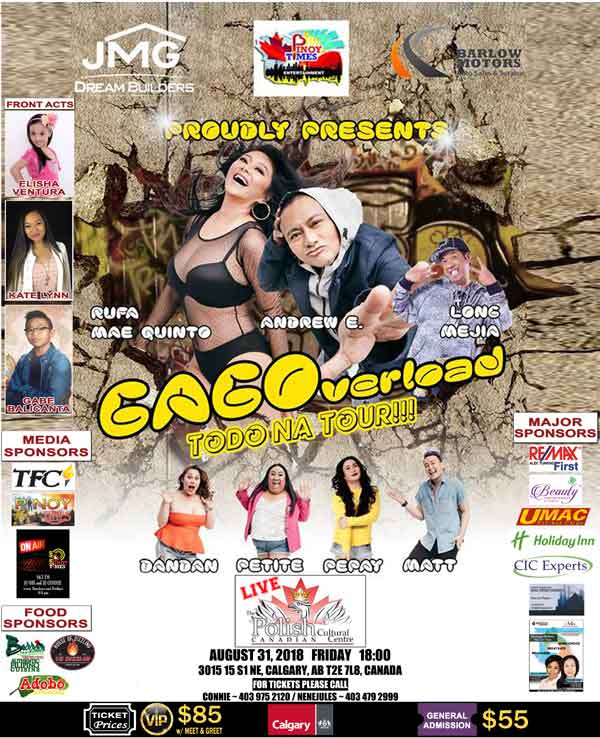- News Front Page
- Uncategorized
- Headline News
- Filipino Calgarian
- Business
- Pinoy Stories
- Community News
- Publisher's Note
- The Main Ingredient
- Views and Opinions
- Maikling Kwento
- Alberta News
- OFW – Month
- Travel News
- Health and Lifestyle
- Pinoy Toons
- Pinoy Spirit
- Entertainment
- The Philippine Lawyer
- Horoscope
- Greetings
- About Us
- Greetings From the Prime Minister
- Greetings from the President of the Philippines
- Greetings from the Premier of Alberta
- Greetings from the Mayor of Calgary
- Advertise With Us
- Disclaimer
- Subscription
Publisher's Note
- Publisher’s Note
 The year just flew by, it ’s barely 45 days and we’re into 2019. It is amazing that with the change of season, that’s how fast we can feel that the year is almost over. We started getting snow here and there and yet we’re still in the fall season.
Mid-October to early November was a [...]
The year just flew by, it ’s barely 45 days and we’re into 2019. It is amazing that with the change of season, that’s how fast we can feel that the year is almost over. We started getting snow here and there and yet we’re still in the fall season.
Mid-October to early November was a [...]
Visitors to Pinoytimes
Page added on September 27, 2018
As the Statues Come Down
Editorial by:
Dennis Paglinawan
Canada has undergone a shift in the way it has executed redressing historical injustices Aboriginals or First Nations people in this country have endured due to British and French colonialism. Verbal apologies, the erection of facilities – such as the Canadian Museum for Human Rights, which plays a role in Canada’s reconciliation process with Indigenous groups – the removal of statues of key historical figures from public properties and the re-naming of public structures, have unfolded in the media. This includes in the last few years the removal of Edward Cornwallis’ statue in Halifax, the renaming of the Hector-Louis Langevin Bridge to the Reconciliation Bridge in Calgary, as well as the removal of Sir John A. MacDonald’s statue in Victoria.
Do these actions suggest that political correctness has gone amok with regard to our colonial history, or have Canadians been progressive in refining what should be accepted to be part of their historical narrative? This issue has been a very polarizing one – some perspectives argue that we should stop celebrating images of people who played key roles in the oppression and genocide of peoples, – that the time has come to bring forward the truths of historical atrocities once ignored by Canadian governments, while other perspectives include the views that people in history are just that – part of history that cannot be ignored and should not be completely demonized in the backdrop of the work they did to form a great country. Tough debate, but is there no compromise on this issue? What does Calgary’s Filipino community say?
A member of the community mentioned that instead of removing statues completely – but without leaving them erect as they are – government jurisdictions could change the narratives that accompany these statues. Plaques affixed to statues and academic texts in schools could, not just acknowledge the achievements of these figures but also, outline the dark involvements of the known atrocities committed by specific individuals. By doing so generations moving forward will know the achievements and the darker parts of their history, and that shaming certain individuals for their actions is the price for what their victims paid for colonialism. Canadians may continue to learn and acknowledge how far their society has come, how much further it progresses towards reconciling how Nations of people became victims during Canada’s colonial past.
As the statues come down before us, do members of Calgary’s Filipino community support the removal of statues of John A. MacDonald and Edward Cornwallis? Do they see these steps as being overly politically correct, or are these steps the progression of Canada’s polity as a democratically reconciled nation and nation of peoples? These are two extreme positions on the issue, and no doubt the views will be multiple in the community.
Perhaps the Filipinos in Calgary have unique perspectives on whether these statues should be taken down; and perhaps this is due to their own colonial past. The Philippines was a Spanish colony and then later an American one after the Spanish-American War. Atrocities can be cited throughout the colonial and pre-WWII eras. Do Filipinos here in Calgary or in the Philippines support the removal of statues of historical figures in Philippine or Canadian colonial history if those historical individuals were tied to any atrocities?
Let us know what you think by emailing us at [email protected]
RELATED STORIES
LATEST HEADLINES
- MOTION RECOGNIZING JUNE AS FILIPINO HERITAGE MONTH PASSES CANADA’S PARLIAMENT
- Manmeet Singh Bhullar Park officially opens in Calgary
- CORONATION OF MS. BARANGAY 2018 OF THE GOLDEN GENERATIONS SENIORS CLUB OF CALGARY
- GLOBALFEST 2018
- ISKWELAHANG PILIPINO (IP) RONDALLA OF BOSTON WINS THE HEARTS OF CALGARIANS
COMMUNITY NEWS
 Canadian Immigration Policy and Filipino-Canadians: Political Complexity, Multiple Objectives, and Rationality Beyond Community Self-Interest
Canadian Immigration Policy and Filipino-Canadians: Political Complexity, Multiple Objectives, and Rationality Beyond Community Self-Interest Manmeet Singh Bhullar Park officially opens in Calgary
Manmeet Singh Bhullar Park officially opens in Calgary One year later, Citizenship Act improvements lead to more new citizens
One year later, Citizenship Act improvements lead to more new citizens On October 17, cannabis is legal in Canada. What does that mean for Calgarians?
On October 17, cannabis is legal in Canada. What does that mean for Calgarians?PINOY STORIES
 Quality education assured with SC ruling on K to 12
Quality education assured with SC ruling on K to 12- Holy Week practices in the Philippines
PINOY SPIRIT
HAVE YOUR SAY
Lorem ipsum dolor sit amet, consectetur adipiscing elit, dolor sit ipsum.PROMOTIONAL BLOCK
Lorem ipsum dolor sit amet, consectetur adipiscing elit, dolor sit ipsum.TRAVEL NEWS
PINOY TOONS
Tags
Archives

















